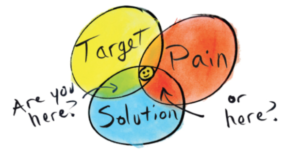My name is Jason Levin and I am a Marketing Consultant for RankSense. I help our users achieve their goals with our technology and educational resources. When I am not working at RankSense, I spend my time reading, writing, exercising, and working on my Facebook Ads agency, Ten Daisies. I have a deep love for books and enjoy sharing my findings with others.
In this article, I will be discussing the main points I highlighted when I read From Impossible to Inevitable: How Hyper-Growth Companies Create Predictable Revenue by Aaron Ross and Jason Lemkin. The book is intended for founders and employees of SaaS start-ups. Aaron was a Senior Director in Corporate Development & Acquisitions at Salesforce before founding PredictableRevenue.com; Jason co-founded EchoSign (which was later sold to Adobe) before becoming a Trusted Advisor at SaaStr, a venture capital firm based out of San Francisco.
Ross and Lemkin focus on what they call the “7 Ingredients of Hypergrowth”:
- You’re not ready to grow until you nail a niche!
- Overnight success is a fairy tale.
- Speeding up growth creates more problems than it solves.
- It’s hard to build a big business out of small deals.
- It will take years longer than you want.
- Your employees are renting, not owning their jobs.
- Define your destiny – let your frustrations motivate you!
1. You’re not ready to grow until you nail a niche!
How do you know when you nailed a niche?

Ross and Lemkin argue that it is when you are able to find and sign up unaffiliated customers. This means customers that are not your friends, your co-worker Bob, your LinkedIn connection Gillian, or even good old Grandma Suzy the antique store from across the street. This means cold hard leads. Whether they found you through the internet or you called or door-knocked, they are currently paying you for your software.
If you can get your first 10 clients to sign up and pay you, you can get 20, 100, even more. The first 10 customers will give you a roadmap, feedback, and the path to 1,000 more customers if you listen carefully.
Remember, nail one niche at a time. Salesforce.com started with Sales Force Automation, Facebook began with Ivy League schools, Amazon started with books, etc. Figure out how to do that one niche correctly and the sky is the limit.
2. Overnight Success is a Fairy Tale
There are 3 types of leads:
- Seeds – created from word-of-mouth, networks, relationships
- Nets – from one-to-many marketing campaigns
- Spears – targeted outbound prospecting or business development campaigns
Seeds = Customer Success
Customer success is not just about blindly increasing customer satisfaction, but increasing customer satisfaction that leads to revenue growth. By investing in customer success, you should see:
- Lower churn: the easiest way to make recurring revenue is by keeping the customers you have
- More revenue: More referrals to new customers; more willingness to try and buy other offerings
- Better marketing: You can improve everything in lead gen via case studies from happy customers
Nets = Marketing
Aaron and Jason write, “If you are passionate about social media, go for it. If you’re doing it ‘because you are supposed to’, don’t be afraid to put it on the back burner”. I think this is a really great point! Not every company needs to have a super-active social media with posts every day. What works for a kitchen remodeling company may not work for a software company which may not work for a refrigerator trucking company. Look at what others in your industry are doing. If you can afford to hire an intern who will be responsible for social media, then that is a great option. I heard these young whippersnappers know a thing or two about the interweb.
Ross and Lemkin suggest marketing teams decrease the weight put on impressions aka eyeballs. What they should really be measuring are statistics like what percentage of opportunities booked by Inbound SDRs (responding to inbound leads) and outbound SDRs (dedicated outbound prospectors) are making it to the meeting stage with an account exec. Marketing teams should also be measuring what percentage of marketing qualified leads are converting to customers.
Another great strategy is rather than choosing your form of communication and then figuring out who to target, you choose who you are going to target and then choose your form of communication. You should map out what they want to hear about based off of proven research.
Spears = Outbound Prospecting
Careful targeting is the key to outbound success.

When salespeople have been trained as prospectors, they develop the mind-set and skills to be entrepreneurial and make things happen instead of waiting around for something to happen.
Ross and Lemkin point out that it can take up to 12 months for a Sales Development Representative to turn a profit … so invest your time and money wisely – in someone who will be worth it.
In fact, it can take 3-6 months to go from scratch to quality predictable pipeline generation … so stick it out! This is where having a niche is super important. You can’t target the world with your ads. You need detailed, specific targeting to be successful.
3. Speeding up growth creates more problems than it solves
Hiring is always a difficult task, and Ross and Lemkin point out that startup CMOs often do not make it past 18 months. They argue this is OK as you need a different type of CMO as the business progresses. It starts with the evangelist putting passion before money; then heads to Mr. Make It Repeatable who creates a pipeline of recurring revenue; next to Ms. Go Big who can scale the business; and finally to Mr. Dashboard who spends his days behind the computer staring at dashboards and meeting with managers.
Ross and Lemkin argue that if your company is churning more than 10% of the salespeople, then the salespeople are not the problem. There is something fundamentally wrong with your system.
Additionally, the authors argue that a young startup should let their salespeople help determine their compensation setup. This gives them an ownership mentality rather than the rent-a-job mindset… more about that later.
4. You can’t build a big business out of small deals
Ross and Lemkin compare choosing the size of your deals to deer hunting. While I am not a fan of hunting, it’s a good analogy. Think of the small businesses as rabbits, the big businesses as elephants, and the medium-sized elephants as deer. You can’t live off of just rabbits, and there’s too few elephants to hunt; the sweet spot is deer. There’s more than enough small-medium sized businesses throughout the world to keep a business going. But, every once in a while a rabbit or elephants tastes good too.
When going hunting, there are 3 things every customer wants to know:
- Why buy?
- Why buy from you?
- Why buy now?
To answer the first question, a good salesperson will listen first to the customer’s issues and then sell second. As for the second question, it is important to coach a customer through the process and teach them about the product like a school teacher. When they develop trust in you as a salesperson, it will be clear that you are the right choice. For the third question, it is crucial to create a sense of urgency for the customer; this can be done by pointing out the issues they are currently facing, and the struggles that they are currently encountering and will encounter if they do not fix the problem.
A little bit of math to make matters simple:
Goal: $1,000,000 ARR (Annual Recurring Revenue)
Price A: $250/mo. Price B: $1,000/mo.
How many customers will it take to get to $1,000,000 ARR at each of those prices?
A: ($1,000,000/250) / 12mo. = 333 customers
B: ($1,000,000/1000) / 12 mo. = 83 customers
The point is it is a lot easier to get to your goal with a higher price and less customers than vice-versa. Raise your prices! You can always lower them.
5. It will take years longer than you want
Buckle up! SaaS companies take on average 7 years to IPO or get sold. To me, this sounds low. It takes years of trial and error to develop an audience.
A gentle reminder: not everyone is going to be a Dropbox. But, using growth hacking skills like the ones mentioned in Ryan Holiday’s Growth Hacking Marketing can help. I’ll save that for another article, but it should be noted that the book is a great read.
Another thing Aaron Ross and Jason Lemkin mention in their book is the prevalence of mental health issues in entrepreneurship. Whether it is the entrepreneurial endeavors that cause the issues, that is unknown, but depression was reported 3x as likely for an entrepreneur than for a non-entrepreneur. Ross and Lemkin point out that when starting a SaaS business it will dominate your thoughts and occupy your mind far more than anything in your life – when you’re with your family, on a walk, etc. So beware.
In my experience working at RankSense and running Ten Daisies, I find that entrepreneurship can ultimately be very freeing. I love working remotely – I get to take walks, choose my hours, take meditation breaks, and wear a button-up shirt with no pants! I have worked in an office, and found myself discontent and restless. For the betterment of my mental health, I am committed to working from home at least 75% of my work week even after COVID is over.
6. Your employees are renting, not owning their jobs!
Ross and Lemkin discuss the option of financial ownership, but what they focus on more so is the idea of functional ownership. This means owning part of the company culture. What can they change within the company? Employees don’t want ping-pong tables. They want the ability to work remote.
The authors shared a survey than a manager could send out to their employees and it looks something like this:
- What’s your role? Who’s your manager?
- What do you like about working with your manager and how we sell our product? Please include examples.
- What don’t you like about working with your manager and how we sell our product? Please include examples.
- If you ran things, what would you do differently? Please include details or ideas.
- What else is on your mind? Are you feeling OK?
Ross and Lemkin recommend this survey be anonymous, but that employees can have their identities shared with their managers if they so desire.
7. Define your destiny – let your frustrations motivate you!
Harkening back to the mental health issues of entrepreneurs, Ross and Lemkin dedicate a section of the book to improving your mental health by your work decisions. Do you really want to quit your job and lay on the beach? How happy are those people laying on the beach after 6 months without seeing their friends or family? Do you really want to start a business? Can you see yourself doing it in 5 years?
Ross asks these questions because they are important to know for oneself. Maybe that passion that you enjoy could be a hobby. It doesn’t have to be your business. Ross started sketching and did all the drawings himself for the book.
Following your passion will not mean happiness at every moment. Remember that as you move forward with life, there are ups and downs everywhere.
If you made it this far, then you know From Impossible to Inevitable has some really stellar points throughout it. Ross and Lemkin ended the book on a strong, personal note and so will I.
If you think you cannot do it, then you definitely cannot. If you think you can, then hey, there is a chance you can. Keep on pushing.


